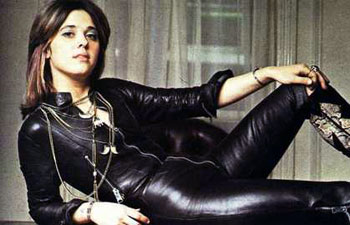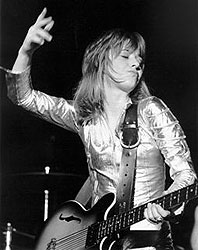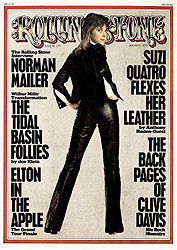Suzi Quatro: Like A Lightning Flash
Published on March 30th, 2011 in: Back Off Man I'm A Feminist, Feminism, Issues, LGBTQ, Music, Soundtracks and Scores, TV |By Cait Brennan

It’s hard to imagine how unwelcome women were in the rock music world of the 1960s. While the titans of what we now call “classic rock” were singing about “social justice” and standing up to The Man, the man they were talking about was definitely not the one in the mirror. Most rock stars used and abused women in ways even their fathers and grandfathers would have found offensive, and the notion that women could rock—or should even be allowed to try—was as foreign to the classic rock era as the idea of an openly gay rock star. (Sorry, Jobriath.)
The pioneering Goldie and the Gingerbreads were the first all-female band to sign with a major label—signed by the always forward-thinking Ahmet Ertegun in 1964. But the Gingerbreads never really had a hit, and despite the explosion of rock music and youth culture, it took four more years—1968!—before another label signed an all-female band, Detroit’s Pleasure Seekers; the following year, the quartet Fanny signed to Reprise. That’s three major-label girl bands, total, for the entire decade of the 1960s.

While female pop singers were ubiquitous, a solo female rock star was almost hard to imagine. That is, until Janis Joplin broke out after the Holding Company couldn’t hold her. Joplin’s star burned bright and fast, and (arguably) the first female rock star was gone almost as soon as she arrived. Almost before the body was cold, labels and impresarios were scouring clubs looking for “the next Janis Joplin.”
It was in this environment that British superproducer Mickie Most (who produced everything from “Hurdy Gurdy Man” to “Kids In America”) found himself in a nightclub in Detroit watching a band called Cradle. Cradle had evolved from the Pleasure Seekers and was likewise built around the Quatro sisters—Patti, Nancy, Arlene, and the youngest, a 20-year old bass wunderkind named Suzi. Wowed by her dynamic, take-no-prisoners performance, Most wanted to sign Suzi Quatro—and only Suzi—to a record deal. And he wasn’t alone: Elektra Records’ Jac Holzman reportedly offered to take Quatro to New York to “make her the next Janis” (a dubious prospect at best, given Joplin’s fate). Suzi chose to go to London with Most, and forge her own path.
After a dud single, Most introduced Quatro to the songwriting duo of Nicky Chinn and Mike Chapman (“Chinnichap”), who’d had big success with The Sweet (Chapman would later have hits with Nick Gilder, Blondie, and the Knack). Together they created a string of million-selling UK hits that distilled Chinnichap’s glitter-pop sensibilities and Quatro’s soulful Detroit rock into an irresistible glam rock stomp. In a matter of months, Quatro tore up the charts with “Can The Can,” “48 Crash,” “Glycerine Queen,” “Daytona Demon,” and “Devil Gate Drive.” The songs were all different but they had elements in common: Deep hooks. Crunchy, layered glam guitars. Massive hand-claps. And best of all, Quatro’s relentless, rock-solid basslines and husky, soulful tenor vocals.

Quatro and Chinnichap cannily capitalized on her fearless, androgynous hotness, shattering stereotypes of gender and sexuality by creating an iconic image that thrilled (and likely terrified) many fans. Clad head to toe in black leather (years before Rob Halford made it fashionable), Quatro sang cover versions of songs like “I Wanna Be Your Man”—pointedly refusing to change the gender pronouns. Barely five feet tall, Quatro fronted an all-male band of big, shady-looking toughs, but her starpower and her attitude were so commanding that there was never any question of who was in charge. On the UK charts and on stage, she could stand toe-to-toe with Marc Bolan, Mott the Hoople, and even David Robert Jones. (Number of UK number ones in 1973 and ’74—David Bowie: 0. Suzi Quatro: 2. )
Despite her success, critics dismissed her as bubblegum, or showed their sexism by smarmily suggesting she was just a clueless prefab puppet of Most and Chinnichap. But Quatro is a high-voltage powerhouse who dominated (and often transcended) her material. She’s also one of the finest bass players the ’70s produced. Quatro was an ace bassist at 15, rocking a ’57 Fender Precision that’s nearly the same size she is (the Precision is 46”). Her first two albums in particular are dominated by the thundering thump of her hollow-body Gibson EB-2. Her frenetic playing style is also hard to miss—Quatro often quite literally rides the bass in performance. That’s one trick, at least, that Carol Kaye never mastered.
Quatro made the cover of Rolling Stone on January 2, 1975, though the article itself was decidedly dismissive, and the magazine’s clueless male rock-snob readership howled in protest that she was featured at all. Still and all, 1975 was a good year for Quatro. After touring with Slade, she opened for Alice Cooper thorough large stretches of his “Welcome To My Nightmare” tour. The stadium tours gave her a chance to showcase what she does best; while her early records are nearly flawless, her blistering live versions are often superior to the recordings. She’s been on the road almost nonstop ever since.
Pages: 1 2
3 Responses to “Suzi Quatro: Like A Lightning Flash”
February 1st, 2014 at 4:48 pm
Well written. Although I don’t think Janis Joplin can claim the Queen of Rock title for her she was more blues.
Suzi made the right decision to go to the UK for sucess Mickie Most did not want her to leave and go back to America that is why her music was never pushed.
I’m sure if given the right promotional push it would of caught fire but it wasn’t meant to be and maybe the US werent ready for a woman who could rock as hard or harder than the men in 1973.
March 12th, 2014 at 9:34 pm
I remember seeing Suzi Quatro in concert twice in America. At the time of her debut release and also at the time of her, “If You Knew Suzi” release. I don’t think Americans hated her, I just think they didn’t really understand Suzi Quatro. No Carly Simon or whoever the popular girls were then in music. Tougher than some male rockers, she may have been observed as a gimmick. The commenter before me states Mickie Most wanted Quatro back in the USA and chose not to push her here. Interesting. I knew some fans of Suzi’s way back when and that crows embraced British rockers (Roxy Music, Bowie, etc.) as did I. Suzi Quatro lead the way (and we’ve heard this before) for Chrissie Hynde, Joan Jett and others. Suzi’s albums were almost great after the debut album eponymously titled and really great was the first. Sophomore slump her second titled “Quatro” and then “Your Mama Won’t Like Me” completed her Mike Chapman Nicky Chinn involvement. The softer more accessible Suzi gave us “If You Knew Suzi” with “Stumblin’ In” for a US hit #4 as well as great covers of Tom Petty’s “Breakdown”, etc. Then the “Happy Days” coincided with her tour and it seemed like the perfect recipe for a rock star here in the USA. It didn’t work that well for Suzi in the USA, although she had other hits here. However, overseas, a triumph. She’s been touring for 50 years, sold 50 million records and has released the best CD since her first with Mike Chapman producing, “In the Spotlight.” The single “Strict Machine” picks up where the first album left off. A great album between some not-so-great albums, and some good ones, too. Her look, sound and image are placed well in music history, as it should be. Barely 5 feet tall and an incredible rocker live. Not to mention she was great on “Happy Days” as Leather Tuscadero. Suzi Quatro. A one of a kind.
October 23rd, 2014 at 8:11 am
phil hit it right on the head. superb power pop, w a hard edge. long live suzy
Time limit is exhausted. Please reload the CAPTCHA.